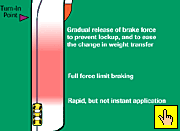Article Topics:
- Overview
- Intro to Racing
- Driving Technique
- Practice Sessions
- Driver’s Gear
- Vehicle Safety
- Handling
- Brakes
- Power
- Tools
TurnFast
recommends
these books:
Articles about Driving Techniques
Braking and Accelerating
One of the keys to good race driving is smoothness, and this most certainly applies to the use of the brake and accelerator pedals.
Braking
On the street, braking and accelerating are done at relatively low levels compared to the vehicle's capability. The tire's traction limits are rarely maxed out. Sure, you can romp on the gas and spin the tires at a light, or slam on the brakes and slide the car a little, but its very easy to bring the car back under control because the amount of traction you need versus what you have is quite low. In other words, you back way off and you're usually right back in control.
In the rain, or especially the snow, you know you have to be much gentler and smoother with the brakes and with the accelerator. If you lose control on a wet or snowy surface, it can be much harder to regain control. There is much less traction to work with.
Braking and accelerating when racing on a road race course, even when dry, is treated something like driving on a wet surface--gently and smoothly. Braking and accelerating are used in conjunction with the corners--you brake going into them and accelerate coming out of them. Because the objective is to have the car moving as fast as possible through the corner, the tires will be utilizing most of the available traction (done right they should be using 100% of the available traction, some would say about 104% which will make sense when we talke more about tires). The driver must be very smooth with the use of the brakes going into the corner and the accelerator coming out of the corner. A sharp change in braking or power at these points will upset the car's traction balance just as quickly as if you were driving on ice. Working within the last 1% of traction means there is no reserve to call upon to gain control of the car back. Even the pros very rarely recover a car that has lost control. It's not because they don't know how, it's because there's no traction left to work with. It is imperative to learn how to be consistently smooth in braking and accelerating on a road course.
There are three phases in braking. First, braking begins with a rapid, but not instant, application of as much braking force as possible. How rapid the brakes can be applied will depend on the the suspension in the car. The stiffer the springs and shocks, the more rapidly maximum braking can be applied. Soft springs will have significant forward roll which will require a little longer and smoother ramp-up of braking to keep the car stable.
Second, once the car settles onto the front tires, you'll be trying to minimize the length of the braking zone, so it will require taking the tires to the edge of locking up. You'll need to be very aware of the vibrations in your foot from the pedal and in your hands from the steering wheel to feel that small difference (therefore racing shoes are highly recommended. You just won't feel much from the pedals in Air Jordans). The car will travel some distance using a fairly constant brake pedal pressure.
The third phase is towards the end of the braking zone when the vehicle has been slowed to near its final speed. Gradually release pressure off the pedal making the transition from full to zero braking force as smooth as possible. During braking, the front tires are under heavy load which increases the available traction. A sudden release of the brakes will abruptly reduce the load and reduce the traction potential of the front tires which at this point is needed for turning into the corner.
The turn-in is one of the points where the car will be the most sensitive to sudden weight transfer transitions as though it were being driven on ice. Indecisive braking resulting in a last second extra tap, or a sudden release of the brake pedal will unsettle the car's handling and force the driver to slow down to gain control and hopefully avoid a spin.
As the braking zone completes, and you ease off the brake pedal, you will have to apply some throttle to reach a steady state of neither acceleration or deceleration. Depending on the shape of the turn, the steady throttle zone will vary, but with a typical late-apex corner, it will be from the turn-in to just before the apex.
Accelerating
From this point to the turn's exit point, the use of the accelerator must be equally smooth for the same reasons they were for braking. Through the turn, the car will have settled with a certain loading of each tire. A sudden change in that with the accelerator can also upset the available traction on one or more tires and cause a loss of control. Controlled use of the accelerator is a matter of depressing and releasing it in smooth motions. Don't make sudden jerks in pedal position.
In a typical street car, applying the accelerator smoothly isn't as difficult to master as smooth braking. Once a car is moving fairly fast, most street cars just don't have enough horsepower to really cause trouble under most acceleration circumstances. Even the factory exotics and highly modified street cars rarely have more than 400 horsepower, and in a car weighing 2500 to 3200 pounds, that just isn't an overabundance of power to learn to control. The typical professional open wheel cars weigh 1500-1800 lbs, and have 700-900 horsepower. That's about 5x the power to weight ratio of your typical street sports car.
Nevertheless, whether its relatively easy to control or not, the introduction of 5 hp too much at the right point, and you may as well have an extra 900. Coming out of a turn, as soon as the car begins to straighten out, gradually apply more power the straighter the car gets. Use smooth consistent pedal pressure--indecisive on and off stabs will end up being slower than a smooth increase.
Because most street cars aren't overly sensitive to rough throttle control (although there are definately some exceptions), it's easy to develop bad habits with the accelerator. Even though you may not have to be ultrasmooth to maintain control, having the discipline to develop smooth control will still improve lap times, and should you have the opportunity to drive a higher horsepower car, you'll have the skills to keep the car pointed in the right direction.
Read Next Article (Cornering)

